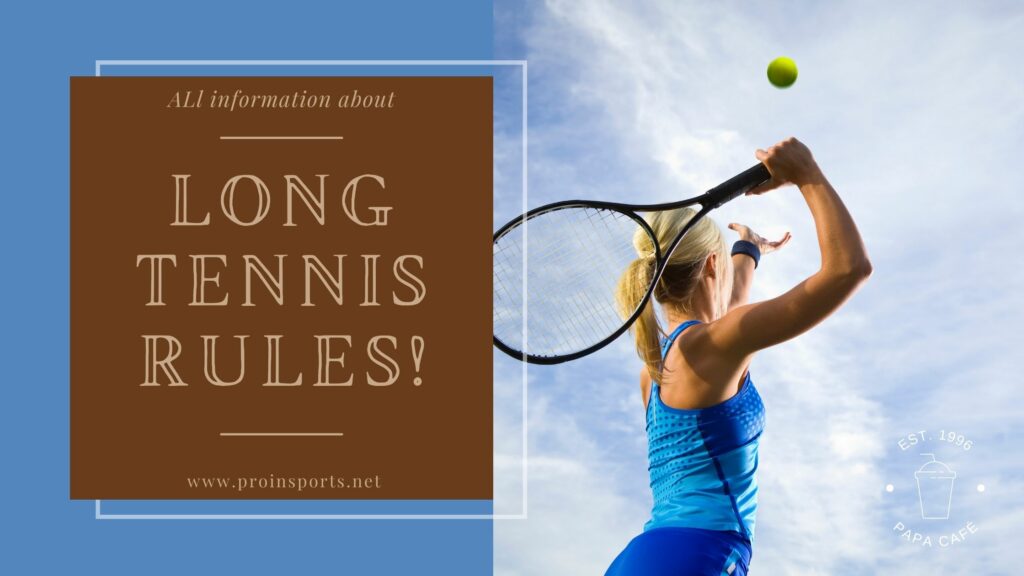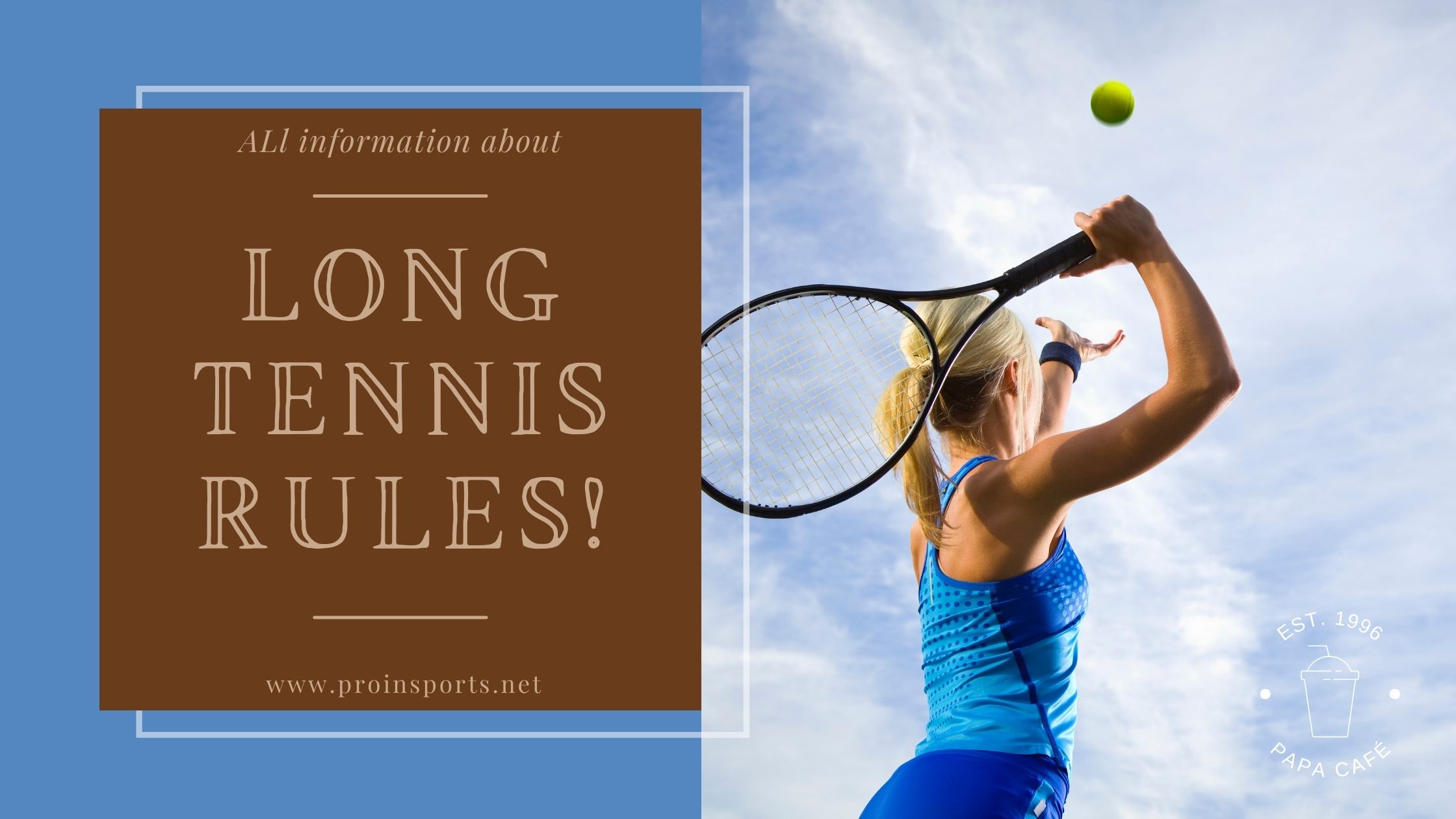Tennis is a widely enjoyed sport that has captured the hearts of millions around the world. Whether you’re a beginner or a seasoned player, knowing the rules of tennis is crucial to enjoy the game to its fullest. In this article, we will break down the long tennis rules in easy-to-understand terms, so you can step onto the court with confidence.
Tennis is a game that takes place on a rectangular court, which can be either indoors or outdoors. Participants use rackets to strike a ball over a net and into their opponent’s section of the court. The goal is to accumulate points, games, and sets in order to emerge as the winner of the match.

The Tennis Court
A standard tennis court is divided into different areas, each with its specific purpose:
Baseline
The baseline is the farthest line at the back of the court. It’s where players start and serve from.
Singles Sidelines
For singles matches, there are two sidelines, one on each side of the court. These lines determine the width of the singles court.
Doubles Sidelines
In doubles matches, the court becomes wider because there are two additional lines, one on each side of the singles sidelines. This extra width accommodates the four players on the court.
Service Boxes
There are two service boxes on each side of the net, one for each player or team. This is where serves must land during a point.
Net
The net divides the court into two equal halves. It stands 3 feet high at the center and gradually gets lower toward the sidelines.
Basic Long Tennis Rules
Now, let’s get into the nitty-gritty of long tennis rules. We’ll explore the fundamental aspects of the game that every player should understand:
The Serve
The serve is how a point begins in tennis. The server stands behind the baseline, and the goal is to hit the ball over the net and into the opponent’s service box diagonally. The server gets two chances (or serves) to start the point, and the point only begins when the ball is successfully in play. If the server makes a mistake, it’s called a “fault,” and they get a second serve. If the second serve is also a fault, the opponent wins the point.
Scoring
Tennis uses a unique scoring system. The points go as follows:
- Love: This is zero, the starting point.
- 15: The first point won by a player.
- 30: The second point.
- 40: The third point. However, if both players or teams reach 40, it’s called “deuce.”
- Deuce: When the score is tied at 40-40, it’s called deuce. To win a game from deuce, a player must win two points consecutively. The first point won is called “advantage,” and the second point wins the game.
Games
In a game of tennis, there are several games played. The set is won by the player or team who achieves at least six games, with a lead of two or more games. To win a match, a player or team usually needs to win two out of three sets (in women’s tennis) or three out of five sets (in men’s tennis).
Let
If a point needs to be replayed due to external interference or a fault, it’s called a “let.” For example, if the ball clips the net on the serve and still lands in the service box, it’s a let, and the serve is retaken.
The Court Boundary
To score a point, the ball must land inside the court boundary lines. If a ball lands on the line, it’s considered “in.” If it lands outside the lines, it’s “out.”
Double Fault
If a server makes two consecutive faults, it results in a “double fault,” and the opponent wins the point.
Foot Fault
A foot fault occurs when the server’s foot crosses the baseline before making contact with the ball. This is also considered a fault.
Also Read: Pickleball Rules
Doubles vs. Singles Tennis
Tennis can be played in both singles and doubles formats, and the long tennis rules differ slightly between the two. Let’s explore the key differences:
Singles Tennis
In singles tennis, it’s a one-on-one battle. Each player serves from one side of the court, and the entire court is in play. The singles court is narrower, making players cover more ground.
Doubles Tennis
Doubles tennis involves two players on each side of the court. The court is wider to accommodate four players. The service is diagonal, meaning that each player serves to the opponent on the opposite side. This format adds an extra layer of strategy and teamwork to the game.
The Let Rule
The “let” rule can often be a source of confusion for tennis newcomers. A “let” is called when a point is replayed, typically due to a minor interference or fault that didn’t significantly impact the game. Some common situations where a “let” might be called include:
- If the ball clips the net on the serve but still lands in the service box.
- If a ball from another court rolls onto your court during play.
- If there’s a loud noise or disturbance while a point is in progress.
When a “let” is called, the point is replayed without any change in score or position. It’s like hitting the reset button for that particular point.
Rules for Serving
Serving is a fundamental part of tennis. It’s how every point begins, and there are specific long tennis rules governing the serve:
The Service Box
When serving, the ball must land within the opponent’s service box diagonally across the net. The server can choose to serve from either the right or left side of the baseline, depending on the score. In singles, they can serve from anywhere behind the baseline. In doubles, the server must stand behind the baseline and between the singles sideline and the center mark.
Foot Fault
To avoid a foot fault, the server must ensure that no part of their foot crosses the baseline before making contact with the ball. Stepping on or over the baseline is considered a fault.
Ball Toss
The server must toss the ball into the air and hit it before it hits the ground. The ball must be hit with the racket head below the server’s waist.
Service Order
In doubles, the service order is crucial. Each team must decide who serves first and in what order. Typically, players on the same team take turns serving, and they switch sides of the court after every game.
Scoring in Tennis
Tennis has a unique scoring system that can be confusing for beginners. Let’s break it down:
Love
The term “love” in tennis refers to a score of zero. When the game begins, the score is “love-all.”
15, 30, 40, and Deuce
Tennis scores progress in increments of 15 points. The first point won is called “15,” the second point is “30,” and the third point is “40.” However, if both players or teams reach “40,” it’s called “deuce.” To win a game from deuce, a player or team must score two consecutive points.The initial point achieved is known as the “advantage,” while the subsequent point secures the victory in the game.
Set and Match
To win a set in tennis, a player or team must win at least six games and have a lead of at least two games over their opponent. A match is typically a best-of-three or best-of-five sets, depending on the level of play.
Rules for Playing
Understanding how to play a point in tennis is essential. Here are the long tennis rules for playing a point:
1. Serving
The player serving starts the point by standing behind the baseline and hitting the ball into the opponent’s service box diagonally across the net. The serve must land within the service box to be considered valid.
2. Returning
The opponent, who is not serving, stands on the other side of the net. Their goal is to return the serve by hitting the ball back over the net and into the server’s court.
3. Rally
Once the ball is in play, players take turns hitting it back and forth. The ball must land within the court’s boundaries. The point continues until one of the following happens:
- A player hits the ball out of bounds.
- A player fails to return the ball before it bounces twice in their court.
- A player commits a fault, such as a foot fault or a double fault on the serve.
4. Scoring
Points are won and lost based on the outcome of each rally. The scoring system used is “15, 30, 40, deuce, advantage, game.” The first player or team to win six games (with a lead of at least two games) wins a set. To win a match, a player or team typically needs to win two out of three sets (in women’s tennis) or three out of five sets (in men’s tennis).
Common Tennis Fouls
While tennis is a friendly and competitive sport, there are long tennis rules in place to ensure fair play. Here are some common fouls that players should avoid:
Tennis Strategies
Tennis is not just about hitting the ball; it’s also about strategy. Here are some basic tennis strategies to keep in mind:
Court Positioning
Where you stand on the court matters. Players should aim to be near the centre of the baseline to have access to the entire court. In doubles, maintaining good positioning with your partner is vital to covering the court effectively.
Serving Strategies
Varying your serve is essential. Mix up your serves by using different spins, speeds, and placements to keep your opponent guessing.
Volleys and Groundstrokes
In addition to serving, tennis involves hitting volleys (shooting the ball before it bounces) and groundstrokes (hitting the ball after it bounces). Mastering these shots and understanding when to use them is key to becoming a skilled player.
Consistency
Consistency is crucial in tennis. Hitting the ball over the net and inside the lines consistently can wear down your opponent and lead to winning points.
Mental Toughness
Tennis can be mentally challenging. Staying focused, positive, and composed during matches is as important as your physical skills.
Final Verdict
Tennis is a wonderful sport that offers excitement, competition, and plenty of opportunities for players to grow and improve. Understanding the long tennis rules and strategies of the game is a vital part of becoming a successful player. Whether you’re playing singles or doubles, serving, returning, or rallying, following the long tennis rules and applying sound strategies will help you excel on the tennis court. So, grab your racket, step onto the court, and enjoy the game of tennis with confidence!
